

|

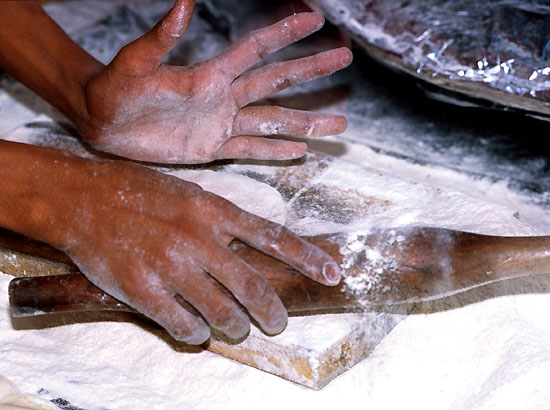
Rolling Chapatis
|
"It is luxurious. (break) ...the ata dough. So after it is cooked... They have got ghee. That ball soaked in ghee and the dal, it is so nice when taken. That is called bati. Very quickly made. And after eating, with that ash the two or three utensils, mean the lota and the plate, they'll cleanse it very nice and walk away. And that food is sufficient for twenty-four hours. Within twenty-four hours he will not be hungry and feel very strong. The two things. And you can cook anywhere without any difficulty. In India, especially in village, you can get so many dried cow dung. So fuel is ready. The ata is packed up. And ghee in a pot. That's all. How simple life. Simply they'll sit down where there is water, and they'll take water. Then everything is arranged. No hotel. Or even there is no ata, they keep their own ghee, homemade, pure. Ata can be purchased anywhere in the village. There is no need of carrying ata."
Srila Prabhupada Room Conversation, 04-29-77, Bombay
|
Srila Prabhupada commented occassionally on the matters of kitchen facility and paraphernalia. When discussing facilities for a particular temple, he referred to having two separate kitchen facilities, one being pakki and the other kachi. In other words, one kitchen whould be ‘expert’, and the other a simpler facility. Srila Prabhupada said that one who is self-sufficient may use simple utensils like banana leaves and clay cups. In the following purport, he described the paraphernalia one might find in a proper Vedic home:
"The walls of the house were made of first-class marble, decorated with valuable jewels. There was no need of light, for the household was illuminated by the rays of these jewels. The female members of the household were all amply decorated with jewelry.
PURPORT:It is understood from this statement that the opulences of household life were exhibited in valuable jewels, ivory, first-class marble, and furniture made of gold and jewels. The clothes are also mentioned as being decorated with golden filigree. Everything actually had some value. It was not like the furniture of the present day, which is cast in valueless plastic or base metal. The way of Vedic civilization is that whatever was used in household affairs had to be valuable. In case of need, such items of value could be exchanged immediately. Thus one's broken and unwanted furniture and paraphernalia would never be without value. This system is still followed by Indians in household affairs. They keep metal utensils and golden ornaments or silver plates and valuable silk garments with gold embroidery, and in case of need, they can have some money in exchange immediately. There are exchanges for the moneylenders and the householders."
Srimad Bhagavatam 3:33:17
 Bhaktivedanta Book Trust. HDG A.C. Bhaktivedanta Swami Srila Prabhupada. Bhaktivedanta Book Trust. HDG A.C. Bhaktivedanta Swami Srila Prabhupada.

Following are a variety of the kitchen tools associated with cooking Indian food.
Banana Leaf Plates & Cups
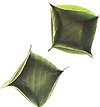
|
Banana leaves are perfect natural thaali plates, and can be folded into bowls, cups or other servingware shapes. To make cups, simply cut circles out of a flat leaf, then pleat or 'crimp' cross sides to make the four corners. Banana leaves can be found fresh and frozen in many Indian and Asian groceries. If your leaves are too stiff to fold, try blanching briefly before use.
|
Chakla-Belan | Chaki-belan (Board and Chapati Rolling Pin)
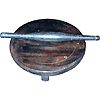
|
Chaklas are round flat platforms made of marble or wood on which the dough for chapattis is rolled with the help of the Belan, or the rolling pin.
|
Chimta (Flat Tongs)
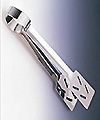
|
Chimta are flat Indian tongs, often used to roast rotis or papads on an open flame. Tongs come in many shapes and sizes, and most cooks keep a variety on hand for different tasks.
|
Chinese Wok
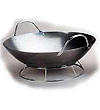
|
A high quality hand-hammered steel wok is a great addition to the Indian kitchen. The shape of Chinese style woks makes them great for frying chenna, pakoras, and other savories. You can use very hot oil, while the wok's shape reduces the number of pieces likely to stick to the bottom due to high heat. The sloped sides also make it easy to drop new pieces into the oil without splashing.
|
Degchi | Dekchi (Narrow-Neck Pot)
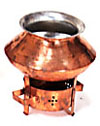
|
The Degchi is traditionally made of brass or copper, but stainless steel is also available today. The Degchi’s neck is narrower than its round, thick base, making it a versatile pan for cooking sauces, gravies and milk-base dishes.
|
Hamal Dista | Mortar and Pestle

|
Mortar and pestle sets come in all shapes and sizes. I don't care much for the marble type, but prefer a rougher stone like the one pictured. Put whole spices in the bowl, and grind to a fine, fresh powder with the pestle. Hand-grinding spices adds a wonderful dimension to cooking. When you need to do quantities, or don't have much time, an electric spice grinder comes in handy. I've found that the small Braun coffee grinders work beautifully, and will even chew through cinnamon bark in short order. Mine has been going strong for 12 years!
|
Handi (Thick Bottom Pot)
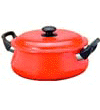
|
The Handi is a thick bottom pot that helps keep foods from sticking or burning. Stick to the better quality cast iron or stainless steel. While more expensive, it's much healthier than cooking in aluminum pots.
|
Kadhai | Karai (Indian Wok)
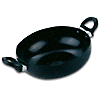
| A Kadhai is the Indian equivalent of a Chinese wok, being deeper and narrower. Kadhai cooking is quick preparation of vegetables, etc., using no water, but taking advantage of the natural juices released by the dish, which is constantly stirred until cooked. The heavier-bottomed Kadhai are best, because you can apply more heat without having to add more oil to prevent sticking.
|
Katori (Serving Bowl)
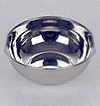
|
Katoris are the small stainless steel bowls typically used to serve dals and curries on a thaali plate. They come in a range of sizes today, and having a good collection on hand is very helpful. They work well for sweets, chutneys and raitas, etc.
|
Masala Dabba (Spice Box)
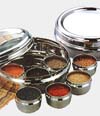
| The Masala Dabba spice box is one of the most important tools in the Indian kitchen. This round stainless steel box holds several cups that fit snugly in the box, keeping spices fresh and ready for use. Most come with one or more small measuring teaspoons and a tight inner lid that keeps the spices from intermingling. I keep several masala dabba in the pantry: One box holds the ‘basic’ spices I use in many preps: turmeric, cumin, asafetida, ginger, coriander, mustard seeds, red chili. Another box contains my favorite aromatics: fennel, nutmeg, cardamom, cinnamon, anise, garam masala, and clove. A third box contains fresh ground masala mixes, each with a very distinctive regional flavor: Bengali, Punjabi, Gujarati, etc.
|
Parat (Rimmed Plate)
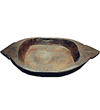
|
The Parat is a high-edged plate usually made of wood, in which dough is kneaded.
|
Tava | Tawa (Iron Griddle)
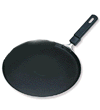
|
The Tava is an iron griddle used for shallow frying or making Indian breads. Over time, the griddle becomes well seasoned and produces a cooking effect you’ll know intuitively.
|
Thaali (Serving Tray)
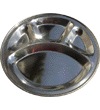
|
Thaali are individual serving plates used to hold foods both on the tray and in a number of smaller bowls, cups and containers. Choose thaali made of good quality stainless steel. They come with or without divided sections. The sectional plates are nice for smaller meals, while the completely flat thaali are typically used for large or formal multi-course feasts.
|
Three-Tiered Steamer
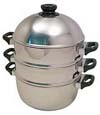
|
In her classic cookbook, "Lord Krishna's Cuisine", Yamuna devi talks about the now-famous piece of cookware known by the devotees as "Srila Prabhupada's cooker". In it, he personally cooked and taught his disciples how foodstuffs should be prepared for the Lord. Srila Prabhupada's cooker was a small, three-tiered brass steamer. He would cook dal or shukta in the bottom compartment, steam the vegetables in the middle, and double-steam rice in the top, preparing an entire meal in about 45 minutes. While such small steamers are unfortunately very difficult to find on the market today, larger versions like the one picture here are readily available.
|
Tiffin (Compartmental Cannister)
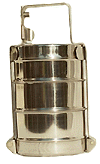
|
Tiffins are multi-sectioned stainless steel carrying cannisters for transporting foods to school, office or elsewhere. Foods are kept hot and secure during transport, and separate portions are easily removed from the stack.
|


|
|